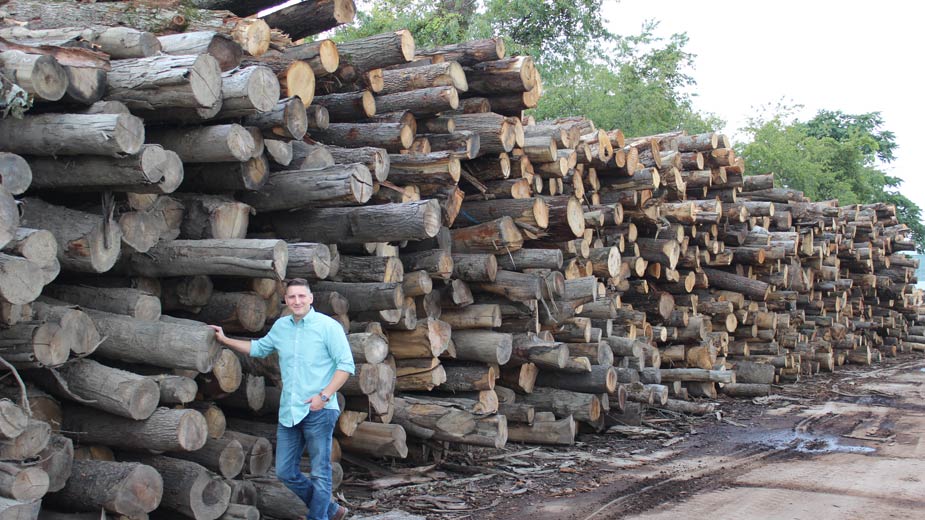Region’s Lumber Industry Grows with Abundance of Hardwood Forests
YOUNGSTOWN, Ohio — Surrounded by some of the best hardwood forests in the nation, loggers in northeastern Ohio and western Pennsylvania have their pick of the lumber.
The Appalachian Mountains and the foothills to the east and west, some 65.7 million acres of forest by Appalachian Hardwood Manufacturers’ count, are home to walnut, oak, maple, cherry and poplar trees.
“Walnut is always the rock star. That’s the one that’s most valuable and highest-priced,” says Eric Doll, sales manager of Doll Lumber Co. in Southington. “Cherry is pretty popular. Hard maple is a good one. Red oak is our bread and butter. There’s a lot of good red oak around here.”
But unlike their softwood counterparts – such as pine, cedar and fir – out west and down south, these trees aren’t destined to be timber for construction projects.
Instead, the highest quality will be turned into the accents for homes – tables, flooring, molding, doors and the like – while lower-grade wood is used in industrial settings, such as the dunnage the steel tube industry uses to hold product in place while it’s shipped.
“At our operation, we’re looking for grade trees that are more of a higher grade. They’re a little larger in size, better quality,” says Kent Mitcheltree, president of Mitcheltree Bros. Logging & Lumber in Pulaski, Pa. “It’s excellent quality and we see a lot of exporting [in this industry].”
 Kent and Darrell Mitcheltree own and operate Mitcheltree Bros.
Kent and Darrell Mitcheltree own and operate Mitcheltree Bros.
Mitcheltree, founded in 1991, and Doll, founded in 1985, each employ about 20.
The wood that the region’s logging companies harvest comes from private landowners and commercial developers. Sometimes, says Omega Inc. President Patrick Chovan, it’s someone looking to clear space for a shed or increase the size of his backyard. Other times, a site needs to be cleared for development, although the former is the Wheatland company’s bread and butter.
All three companies typically work within 50 miles of their sawmills.
In total, Omega produces about 300,000 board feet – the standard unit of measurement in the industry, equivalent to a board 12 inches long, 12 inches wide and one inch thick – of lumber per week. Mitcheltree Bros. has gone as high as 100,000 board feet per week, its president says.
Doll Lumber produces roughly 48,000 per week, or 200 logs daily, Eric Doll says.
That might seem like a lot of lumber, Mitcheltree says, and it is. But with conservation and prudent foresting efforts over the past few decades, the size of the nation’s forests is growing. Within Ohio are about eight million acres of woodlands compared to six million in 1965. Across the state line, Pennsylvania has roughly the same amount of forested lands, although the number of large-diameter trees – those suitable for logging – has increased to about 11 million from six million in 1963.
“It is, in my opinion, the absolute greenest industry you can have. You take a renewable resource and cut it down to allow for younger growth,” Chovan says. “And we don’t waste any part of the tree. All our wood chips go out for laminate flooring and pressed boards. Our bark goes for mulch. Our sawdust goes for animal bedding. We use every single part of the tree.”
The same practices are in effect at Doll Lumber and Mitcheltree Brothers.
Rather than the clear-cutting seen in decades past, loggers today prefer to use a process known as select cutting, where they fell only trees above a certain size or certain species.
“You want a nice, straight, round tree,” Doll says of what foresters are looking for. “You’re looking for knots and the basic quality.”
The decision on what to take down, however, lies with the landowner.
“We try to guide them with what we think would be best for their piece of property,” Mitcheltree says. “In the end, they own the property and they own the woods. It’s up to them.”
After the decision has been made, the companies get to work. Mitcheltree and Omega, established in 1976, contract out their felling operations, while Doll has its own two-man crews traveling throughout the region to bring lumber back to its sawmill in Southington.
At Omega, the logging contractors – 10 companies have exclusive contracts with Omega, Chovan says – sort the wood with higher-quality woods sent to its mills in Clintonville, Pa., and lower-quality wood sent to Wheatland, Pa. Between its two sites, Omega has about 70 workers.
During the summer, logging companies aim to keep turnover of their timber high. There is a lot of water in freshly cut wood and, during the warmer parts of the year, that can lead to mold growing on the wood or the wood rotting if it’s left to sit too long.
“If it sits around and rots, you get some discoloration in the wood,” Mitcheltree says. “We try to get them out in about two or three weeks, during the summer at least. In the winter, when it’s cold, the mold doesn’t grow as fast.”
Once inside the sawmill, the logs pretty much follow the same path, regardless of site. They’re first sent through a debarking machine that spins the log beneath arms that scrape off the bark, with what’s removed turned into mulch.
 With the help of a crane, Doll Lumber’s Reuben Childs moves a pallet of wood that’s been sorted by species and size.
With the help of a crane, Doll Lumber’s Reuben Childs moves a pallet of wood that’s been sorted by species and size.
The bare timber heads to a sawyer, who trims off the outer, uneven layers of the log with the assistance of laser-guided saw blades. Once the outer parts are done and the log is square, the results better resemble the planks found in lumberyards and sent on to a grader.
For those uneven pieces, there’s another step between sawing and grading: edging. Here, the sides are trimmed off to even out the log and make it suitable to be turned into moldings, cabinets, doors or whatever use the buyer has in mind.
The grader takes a look at the size and grain of the board and ranks it anywhere from “firsts and seconds,” or FAS, to No. 3B Common, the former purchased to make products such as cabinetry and hardwood furniture, the latter for fences, crates and industrial uses.
To help price their final products, logging companies turn to the Hardwood Market Report, a weekly report that lists the going rate for every species, size and grade of lumber in each region – Southern, Appalachian and Northern.
At the close of 2016, 4/4 FAS walnut – that is, a plank of top-quality walnut one inch thick – averaged $2,515 per thousand board feet in the Appalachian region, which includes the Mahoning and Shenango valleys. White oak of the same size and grade ranked second at $1,715 per thousand board feet.
Ash trees, once a staple in the Appalachian region, have almost disappeared, the loggers note. In the 2000s, emerald ash borer infestations began popping up throughout the Midwest and Appalachia, spreading as infested logs were shipped from one state to another. They wiped out the ash population.
“You’ve taken a whole [species] out of it. It’s decreased landowners’ assets and anybody who had a patch, it got bought up,” Chovan says. “The Pennsylvania [state and national] forests had huge sales for their ash to try and get something out of it before it was gone.”
If done right, Mitcheltree explains, tree harvesting can be a source of income for decades. Most loggers look to take down trees that are about two feet or larger in diameter. For those left behind, the woods will be ready for harvesting in 20 to 25 years.
“If [landowners] harvest correctly and manage correctly, it’s an income for years and generations to come,” he says. “With hardwood, it always comes back. There’s natural regeneration.”
Because of the species in Appalachia, the industry here isn’t subject to the same fluctuations elsewhere in the country. In the Pacific Northwest, wildfires scorched softwood forests over the summer, which sent lumber futures soaring, with prices rising as much as 7% in a week in mid-July, according to Bloomberg. More recently, Hurricane Irma sent lumber futures up 5% the week before it made landfall, according to CNBC, because of the threat to southern softwood harvesters.
While those loggers are looking out for hurricanes and wildfires, the loggers around here are more concerned with the weather, although their opinions on what’s coming from the sky are most likely the opposite of an Average Joe.
“Weather affects us when it rains. Loggers can’t work because of the ruts that we’ll make and it makes cleanup a lot harder,” Chovan says. “We like really cold winters because the ground firms up and you can’t make ruts.”
Environmental stewardship has set the timber industry up for success in the years to come.
“Loggers have, in the past, gotten a bad rap,” Doll says. “Most of us want to leave the forest better than we get it and ready for regrowth, both environmentally and economically.”
Pictured at top: Omega Inc. in Wheatland, Pa., processes about 300,000 board feet of lumber every week, according to President Patrick Chovan.
Copyright 2024 The Business Journal, Youngstown, Ohio.


